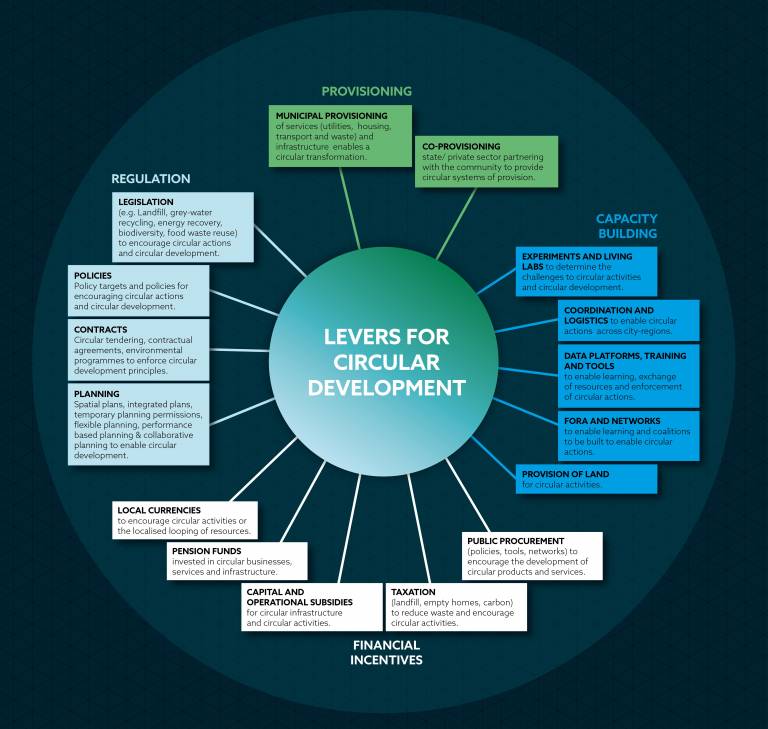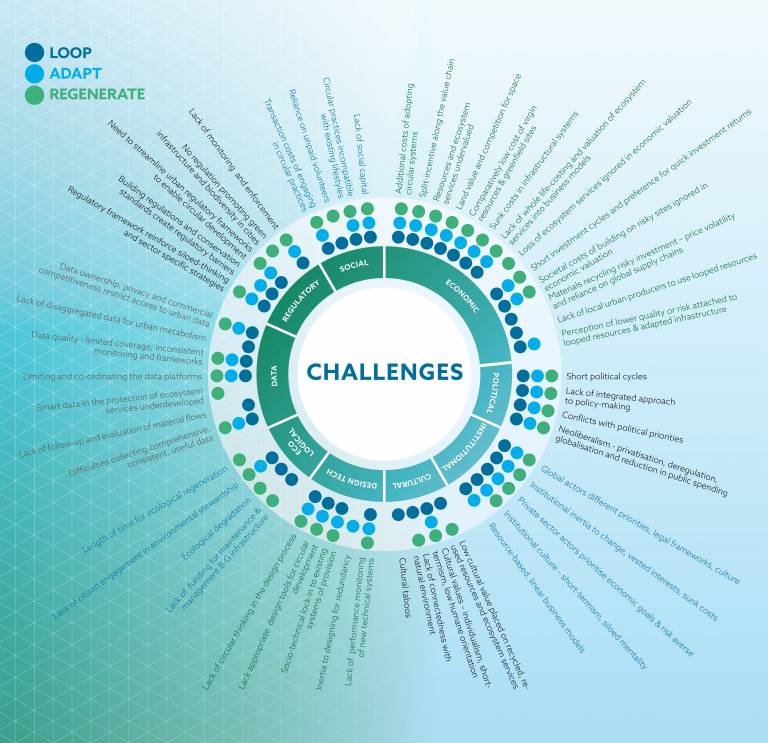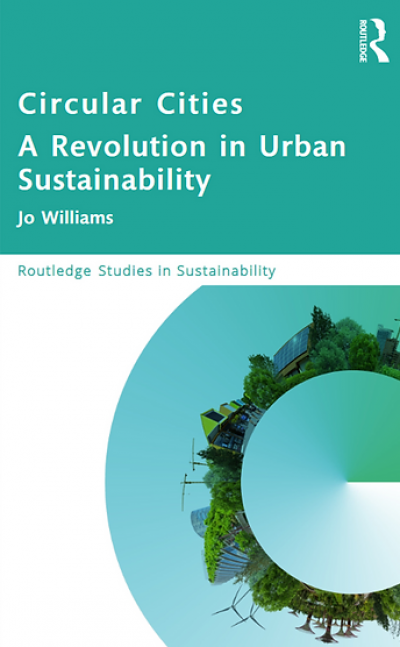
Implementing circular development;
- Levers for implementation
There are many levers currently being used by cities to deliver circular development©. Here are the main levers being employed in European cities

Source: Williams, J (2021) Circular Cities: A revolution in urban sustainability, Routledge and credits Draught Vision Limited.
For more detailed information please read:

Circular Cities: A Revolution in Urban Sustainability
By Jo Williams
Routledge: London. https://doi.org/10.4324/9780429490613
With cities striving to meet sustainable development goals, circular urban systems are gaining momentum, especially in Europe. This research-based book defines the circular city and circular development. It explains the shift in focus from a purely economic concept, which promotes circular business models in cities, to one that explores a new approach to urban development. This approach offers huge opportunities and addresses important sustainability issues: resource consumption and waste; climate change; the health of urban populations; social inequalities and the creation of sustainable urban economies. It examines the different approaches to circular development, drawing on research conducted in four European cities: Amsterdam, London, Paris and Stockholm. It explores different development pathways and levers for a circular urban transformation. It highlights the benefits of adopting a circular approach to development in cities, but acknowledges that these benefits are not shared equally across society. Finally, it focuses on the challenges to implementing circular development faced by urban actors. This ground-breaking book will be essential reading to scholars, students, practitioners and policymakers interested in the circular economy, urban sustainability, urban ecology, urban planning, urban regeneration, urban resilience, adaptive cities and regenerative cities
- The role of planning
Spatial planning provides a powerful tool for delivering circular development © in urban systems. This paper discusses how planning has been used for this purpose across several European cities:
For more detailed information please read:

Circular Cities: Planning for Circular Development in European Cities
By Jo Williams
European Planning Studies, DOI: 10.1080/09654313.2022.2060707
Circular development could produce more resource efficient, ecologically regenerative and resilient cities. This development pathway offers many ecological, social and economic benefits. However, there are also many challenges to implementation, not least a heavy reliance on the market to transform urban systems of provision. A regulatory and policy framework is essential for a circular transformation, until circular activities become competitive within existing markets. Spatial and land-use planning can offer this framework. This paper provides insight into the circular development process. It discusses the role of planning in delivering circular development, using examples from four European cities. It identifies the tools for delivery and discusses the inherent limitations of using planning tools to deliver a circular transformation.

The Role of Spatial Planning in Transitioning to Circular Urban Development
By Jo Williams
Urban Geography, https://doi.org/10.1080/02723638.2020.1796042
Circular development necessitates the socio-ecological transformation of our urban systems. It requires that “wasted” resources are looped; the ecological regenerative capacity and adaptive capacity of urban systems are developed. The end result will be healthier urban ecosystems, with low levels of resource consumption and wastage. Spatial planning potentially has a crucial role to play in the delivery of circular development. However, it has an ambiguous legacy, demonstrated by London, Paris and Amsterdam. It will need to go beyond the allocation of temporary spaces for circular experimentation, if it is to enable the transition. It will need to intervene in markets to provide space for low-value, circular activities and enable the localised looping of resources within city-regions. It should support infrastructure needed for circular actions and ensure urban form continues to support circular systems adopted. Finally, planners can generate demand for circular activities and products, through conditions placed on new developments.
- The challenges to implementation
There are many challenges to the implementation of circular development ©.

Source: Williams, J (2021) Circular Cities: A revolution in urban sustainability, Routledge and credits Draught Vision Limited.
For more detailed information please read:

Challenges to implementing circular development – lessons from London, International Journal of Urban Sustainable Development (forthcoming)
By Jo Williams

Circular Cities: A Revolution in Urban Sustainability
By Jo Williams
Routledge: London. https://doi.org/10.4324/9780429490613
With cities striving to meet sustainable development goals, circular urban systems are gaining momentum, especially in Europe. This research-based book defines the circular city and circular development. It explains the shift in focus from a purely economic concept, which promotes circular business models in cities, to one that explores a new approach to urban development. This approach offers huge opportunities and addresses important sustainability issues: resource consumption and waste; climate change; the health of urban populations; social inequalities and the creation of sustainable urban economies. It examines the different approaches to circular development, drawing on research conducted in four European cities: Amsterdam, London, Paris and Stockholm. It explores different development pathways and levers for a circular urban transformation. It highlights the benefits of adopting a circular approach to development in cities, but acknowledges that these benefits are not shared equally across society. Finally, it focuses on the challenges to implementing circular development faced by urban actors. This ground-breaking book will be essential reading to scholars, students, practitioners and policymakers interested in the circular economy, urban sustainability, urban ecology, urban planning, urban regeneration, urban resilience, adaptive cities and regenerative cities.

Circular Cities: Challenges to Implementing Looping Actions
By Jo Williams
Sustainability, 11(2), 423; https://doi.org/10.3390/su11020423
Currently cities consume 60–80% of natural resources globally. They produce 50% of global waste and 75% of green-house gas emissions. The UN estimates that 66% of the world’s population will live in cities by 2050 while the global urban footprint will triple over the years to 2030. Thus cities, as a system of production and consumption, threaten the environmental sustainability of the globe. Looping actions—reuse, recycling and recovery of resources (materials, energy, water, land and infrastructure)—can help to address resource scarcity and wastage in cities. However, there are many challenges to implementation. Much of the literature explores the challenges to looping actions within resource sectors and for specific actions (i.e., challenges to adaptive reuse of buildings, recycling of material waste, energy recovery from sewage). It often does so without any clear reference to context. Nexus solutions are becoming a popular resource looping response to tackling wastage in cities. Some of the challenges to implementation have been explored, but influence of context has not been investigated. In this paper we explore the challenges facing the implementation of looping actions in cities. Using a mixed methods approach, we identify 58 challenges to looping actions across eight themes. We also establish the challenges to implementing a nexus solution. The research identifies five common implementation challenges. Addressing these challenges could enable looping actions across resource types in cities. The research also demonstrates how context affects the challenges to implementing looping actions and nexus solutions in cities. Nevertheless, the analysis suggests that there are some common levers for promoting looping actions and nexus solutions in cities, regardless of context.
 Close
Close


 Professor Jo Williams is the founder and Director of the Circular Cities Hub. She is an expert in regenerative, low carbon, resource looping and adaptive urban systems. She has acted in an advisory capacity for international organizations including: UN Habitat, UNEP, European Environment Agency, European Investment Bank and OECD. She has also been engaged by nation states, consultants and cities to advise on the implementation of ecologically regenerative urban systems. She is the author of over 100 publications, including two books - Circular Cities: a revolution in urban sustainability
Professor Jo Williams is the founder and Director of the Circular Cities Hub. She is an expert in regenerative, low carbon, resource looping and adaptive urban systems. She has acted in an advisory capacity for international organizations including: UN Habitat, UNEP, European Environment Agency, European Investment Bank and OECD. She has also been engaged by nation states, consultants and cities to advise on the implementation of ecologically regenerative urban systems. She is the author of over 100 publications, including two books - Circular Cities: a revolution in urban sustainability 
